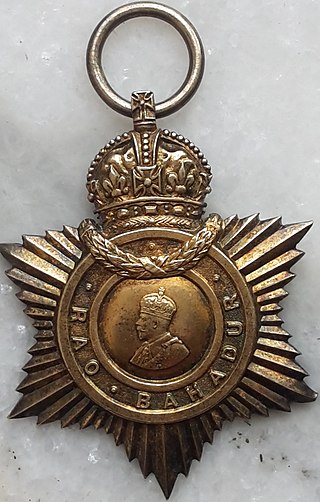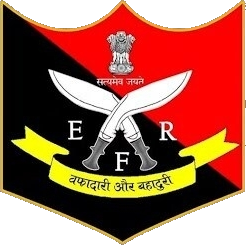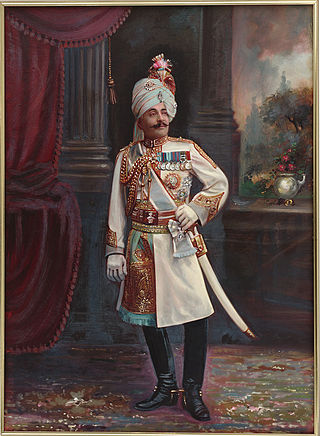Orders
Orders of chivalry
-
 Order of the Star of India (1861–1947)
Order of the Star of India (1861–1947) -
 Order of the Indian Empire (1878–1947)
Order of the Indian Empire (1878–1947) -
 Order of the Crown of India (1878–1947)
Order of the Crown of India (1878–1947)
Order of merit
-
 Order of British India (1837–1947)
Order of British India (1837–1947)
With the inception of Company rule in India by the East India Company in 1757, the tradition of giving medals also began. Campaign medals and awards were given to soldiers who fought in the Company's presidency armies (Bengal Army of Bengal Presidency, Madras Army of Madras Presidency and Bombay Army of Bombay Presidency). After 1895, with the formation of British Indian Army, soldiers were awarded with gallantry awards alongside Imperial Service Troops of the princely states. Awards were also bestowed upon the personnel of Royal Indian Navy and of Royal Indian Air Force with its incorporation in 1932. Indian Imperial Police were also eligible for the police honours.
The company's powers were removed in 1858 after the Indian Mutiny, and the British Crown assumed direct control of India and monarch took the title of Emperor of India in 1876. During the British Raj, new medals and orders were established and were awarded for the services to the Crown and the Indian Empire by Europeans and Indians of British India and the princely states. After 1914, Indians also became eligible for British Honours. The following is a list of orders, decorations and medals related to British in India: [1] [2]

The Most Eminent Order of the Indian Empire is an order of chivalry founded by Queen Victoria on 1 January 1878. The Order includes members of three classes:
British campaign medals are awarded to members of the British Armed Forces, Allied forces and civilians participating in specified military campaigns. Examples include the Defence Medal, for homeland defence in World War II, and the Atlantic Star for World War II sea service in the Atlantic.

The Indian Order of Merit (IOM) was a military and civilian decoration of British India. It was established in 1837, although following the Partition of India in 1947 it was decided to discontinue the award and in 1954 a separate Indian honours system was developed, to act retrospectively to 1947. For a long period of time the IOM was the highest decoration that a native member of the British Indian Army could receive and initially it had three divisions. This was changed in 1911 when Indian servicemen became eligible for the Victoria Cross. A civilian division of the IOM also existed between 1902 and 1939, however, it was only conferred very rarely.

The Order of British India was an order of merit established in 1837 by the East India Company for "long, faithful and honourable service". The company's powers were removed after the Indian Mutiny, and the Order was incorporated into the British Honours System in 1859. The order became obsolete in 1947, after the partition of British India into the Dominion of India and the Dominion of Pakistan.

Rao Bahadur and Rai Bahadur, abbreviatedR.B., was a title of honour bestowed during British rule in India to individuals for outstanding service or acts of public welfare to the Empire. From 1911, the title was accompanied by a medal called a Title Badge. Translated, Rao means "King", and Bahadur means "Brave". Bestowed mainly on Hindus, the equivalent title for Muslim and Parsi subjects was Khan Bahadur. For Sikhs it was Sardar Bahadur.

Maharajah Sir Jagatjit Singh Sahib Bahadur was the last ruling Maharaja of the princely state of Kapurthala during the British Raj in India, from 1877 until his death, in 1949. He ascended to the throne of Kapurthala state on 16 October 1877 and assumed full ruling powers on 24 November 1890 as well indulging in traveling the world and being a Francophile. He was born in an Ahluwalia Sikh family. He received the title of Maharaja in 1911. He built palaces and gardens in the city of Kapurthala; his main palace, Jagatjit Palace there was modelled on the Palace of Versailles. He also built a gurdwara at Sultanpur Lodhi.
The 101st Regiment of Foot (Royal Bengal Fusiliers) was an infantry regiment of the East India Company and British Army that existed from 1652 to 1881. The regiment was raised in India in 1652 by the East India Company as the company's first non-native infantry regiment. Over the following two centuries, the regiment was involved in nearly all of the East India Company's conflicts which consolidated British rule over India. The Royal Bengal Fusiliers was transferred to the command of the British Army in 1862 following the Indian Mutiny of 1857 and the end of Company rule in India. Under the Childers Reforms it amalgamated with the 104th Regiment of Foot (Bengal Fusiliers) to form the Royal Munster Fusiliers in 1881.

The Eastern Frontier Rifles (EFR) are a State Armed Police Force for the Indian state of West Bengal. They are a part of the West Bengal Police, as opposed to the Kolkata jurisdiction. The Border Guards Bangladesh are descended from the portion of the Eastern Frontier Rifles given to Pakistan during the partitioning of 1947.

Lieutenant-General Sir Pratap Singh,, was a decorated British Indian Army officer, Maharaja of the princely state of Idar (Gujarat), administrator and Regent of Jodhpur and heir to Ahmednagar later renamed as Himmatnagar from 1902 to 1911.

Maharajadhiraj Shri Maharaja Mahim Mahendra Maharao Raja Sir Umaid Singh II was the Hada Chauhan ruler of the Princely State of Kotah from the year 1889 to 1940.
Rao Bahadur Pemmanda K. Monnappa was a police officer of South India. He served in three Southern states, Madras, Hyderabad and Mysore (Karnataka), at different times. However, he is to be best remembered for his contributions towards the integration of Hyderabad into the Union. Monnappa had a career in the Public Service reflected by his titles and medals.
The Government of India has declared repugnant some battle honours earned by Indian Army units, which are descended from erstwhile units of the Presidency armies under the East India Company and later under the British Indian Army of the British Raj. Indian Army units do not inscribe these battle honours on their colours and do not celebrate commemoration days associated with these battles. This decision was taken post-independence regarding those battle honours concerned with battles in India and Pakistan which the Indian government regards as part of the "subjugation" of India and in some cases, neighbouring countries.

The Seringapatam Medal, or Sri Ranga Pattanam Medal, is a campaign medal that was awarded by the Governor-General of India to all British and Indian soldiers who participated in the British victory in the Battle of Seringapatam in 1799.

Major-General HH Rashtrawar Kulabhushan Maharajadhiraj Shri Huzur Maharaja Shrimant Sir Sajjan Singh Bahadur was an esteemed British Indian Army officer and Maharaja of the Princely State of Ratlam State in modern day Madhya Pradesh, ruling from the year 1893 until 1947 six months before the independence of India from the imperial British Rule.

The Indian Meritorious Service Medal (for Europeans of Indian Army) was a medal to recognize long and meritorious service by European non-commissioned officers in service of the East India Company's Army.
The New Year Honours 1903, announced at the time as the Durbar Honours, were appointments to various orders and honours of the United Kingdom and British India. The list was announced on the day of the 1903 Delhi Durbar held to celebrate the succession of King Edward VII and Queen Alexandra as Emperor and Empress of India. The membership of the two Indian Orders were expanded to allow for all the new appointments.
The 1911 Delhi Durbar was held in December 1911 following the coronation in London in June of that year of King George V and Queen Mary. The King and Queen travelled to Delhi for the Durbar. For the occasion, the statutory limits of the membership of the Order of the Star of India and the Order of the Indian Empire were increased and many appointments were made to these and other orders. These honours were published in a supplement to the London Gazette dated 8 December 1911.
Sardar Bahadur was a title of honour awarded to native Indian civilians and Viceroy's commissioned officers during British rule in India. It was bestowed upon Sikhs, and was awarded for faithful service or acts of public welfare. The title was used after any military rank, but before the title holder's name. From 1911 holders of the title were also awarded a special Title Badge.

Title Badges were presented to Indian citizens who received certain formal titles of honour during British rule in India. They ceased to be awarded in 1947 on Indian independence.